Findings from EDC’s Embedded Developer Survey — August, 2003
Aug 18, 2003 — by LinuxDevices Staff — from the LinuxDevices Archive — 3 views
[Updated Aug. 25, 2003] — Evans Data Corp. (EDC) has released data on several findings from its recently completed survey of nearly 400 embedded developers. The data sheds light on:
- The value embedded developers place on real-time debuggers
- How much time developers spend on… hardware vs. software related issues
- The role developers play in evaluating intellectual property (IP) issues such as SCO's recent claim that Linux violates its IP
- Microprocessor choice
- Perception of Linux's Biggest Technical Difficulties for Embedded
- What Type of Application Most Uses Embedded Databases?
- Perception of Linux's Greatest Strengths for Embedded
- Perception of Linux's Greatest Weaknesses for Embedded
- What Percent Expect to Release an Open Source Program This Year?
- What Percent Expect to Use Open Source Code This Year?
On another note, EDC found that usage of the Eclipse IDE has shown significant growth in the last year from 4% to 10% in the recent survey. All of the IDE's in the survey have gained ground on Microsoft's dominant Visual Developer Studio in the last six months, EDC said.
Below are further details on several of EDC's findings . . .
Importance of, and satisfaction with, real-time debuggers
The EDC survey found that real-time debuggers are the most important tool in the developer's tool kit. But the survey also found that real-time debuggers are less than satisfactory with more than 15 percent of developers reporting that they need improvement.
Real-time debuggers, as opposed to single-step debuggers, enable applications to run at full speed; thus, they are more apt to catch timing-critical bugs that won't show up in single-step mode. A full 68 percent of developers consider these tools to be either very important or critical to their work.
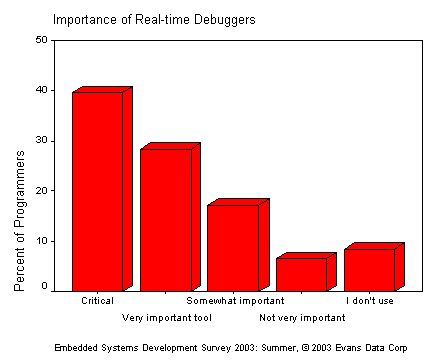
Forty percent of respondents selected real-time debuggers as “Critical to development”. Second most important tool for embedded development were libraries at 27%. When ranked against the other tools in the survey, real-time debuggers had a relative ranking of 77 and libraries were second at 50.
“Relative rankings are used to compare a set of tools or technologies and measure the disparity among the set. They are calculated by assigning a weight to each response, the more positive the response the greater the weight it carries, and aggregating those weighted responses to assign a relative value and rank to each member in the set,” said Brian Cooper, research director for Evans Data.
When developers were asked about their satisfaction with the various tools available for embedded development, eighteen percent of those who had an opinion on this question said they felt that real-time debuggers needed improvement. Thirteen percent felt they were already excellent. Developers are least satisfied with memory analysis tools and performance analysis/profiling tools.
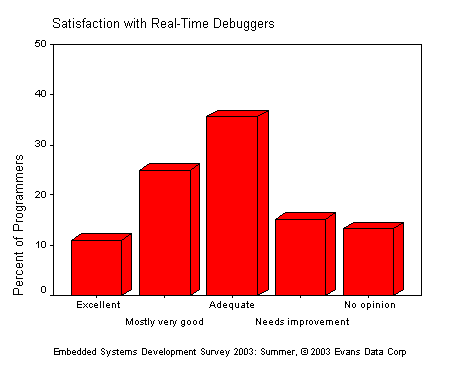
Time Spent On Hardware and Software Issues
According to the survey, 97% of embedded developers split their time between hardware and software development, a sign of the ever growing trend toward design convergence.
The following two graphs illustrate the results found for hardware (above) and software (below) related development:
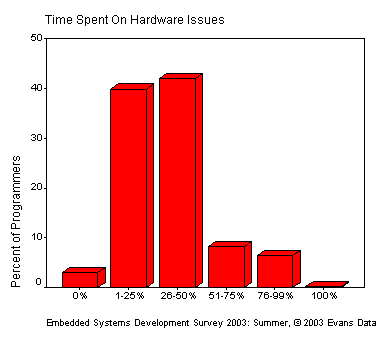
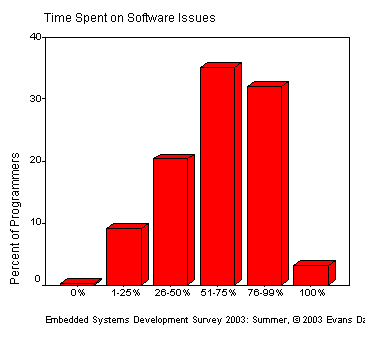
Once a hardware design becomes final, most hardware issues become essentially software issues, as engineers try to work around hardware bugs via software. Thus, it is easy to understand why 85 percent of respondents reported spending less than half their time dealing with hardware issues.
For the same reasons, a full 70 percent of respondents reported spending over 50 percent of their time on software issues.
Evaluation of the Intellectual Property Risks of Linux
EDC found that almost 60% of companies will evaluate the intellectual property risks of Linux, possibly in response to the SCO lawsuit. However, for 34% of respondents that task fell to the developers and engineering teams.
It is surprising that companies using Linux leave the assessment of IP risks largely in the hands of developers, who would rather focus on technical issues and, after all, have no legal expertise in the first place. It is also a little disturbing that 12 percent of respondents said they “did not consider” the IP risks of using Linux. There may be a nascent market here for training in IP issues; either that, or an open invitation for more lawyers to jump into the embedded industry.
The following graph illustrates the answer to the question, “Who was PRIMARILY involved in the intellectional property evaluation of Linux, if you have considered using it in an embedded system?” A table showing the responses appears below the graph.
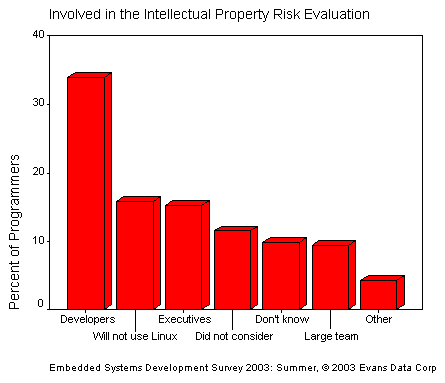

At the top of the list, EDC found performance was the most important consideration, chosen by 29 percent. Developer tools were second-highest, with 23 percent, suggesting that development tools are not keeping up with the hardware and can not be counted on for every platform, according to EDC.
Cost came in third at 21 percent.
The vague “Support” choice received a low response rate, as did “Multi-vendor availability.” The latter is especially important in military apps.
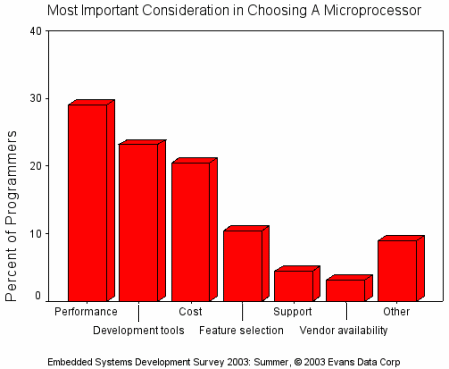
Perception of Linux's Biggest Technical Difficulties for Embedded
The top two perceived technical difficulties are lack of a standard platform and lack of device drivers, according to the EDC data.
EDC notes that the lack of standard platform has been addressed by the Embedded Linux Consortium's Embedded Linux Consortium Platform Standard (ELCPS), Version 1.0.
If the ELCPS is widely adopted, it should reduce worries about the potential fragmentation of embedded Linux, according to EDC. It might also make it easier to write device drivers, thus reducing the number two concern cited in the EDC survey.
The ELCPS is not without controversy, notes EDC. Some industry experts have criticized the ELCPS, and even dismissed its potential effectiveness, because it has not been developed under an Open Source model. EDC deems it too early to evaluate how much influence the ELCPS will have.
EDC found it interesting that “Performance” ranked very low as the biggest technical drawback of embedded Linux, while Real-Time Issues were seen as the number one weakness in a previous question. EDC points out that performance does not equal real-time, but is related.
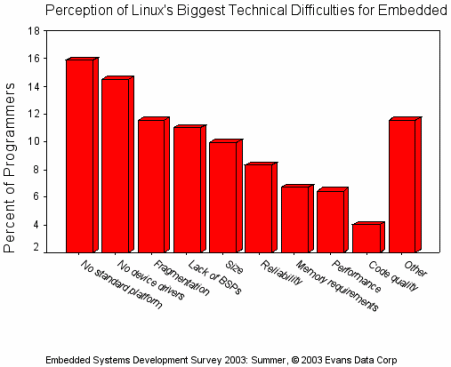
What Type of Application Most Uses Embedded Databases?
Embedded databases used in Portable/Wireless/PDA category are most likely to be used for business applications, such as managing contacts or tracking sales and inventories, found EDC. It notes that the next most frequent application, Field Service/sales device, could easily be a PDA as well.
The large response to the “Other” category (49 percent) implies a great deal of fragmentation in embedded database applications, according to EDC, and this is similar to the situation with non-embedded databases. It is possible that embedded databases are supporting the same kinds of applications, but on a more compact scale.
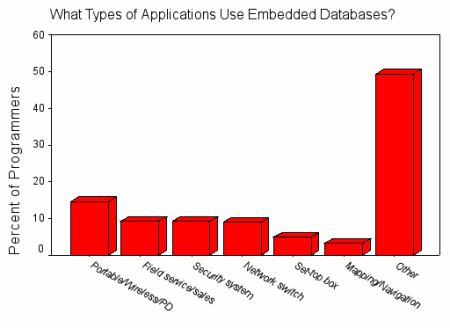
Perception of Linux's Greatest Strengths for Embedded
Developers perceive Linux's greatest strengths as access to source code (31 percent) and absence of run-time royalties (27 percent), says EDC. Portability and tool availability came in a very weak third and fourth place respectively. Note that in the next question, lack of tools was cited as the third biggest weakness of Linux.
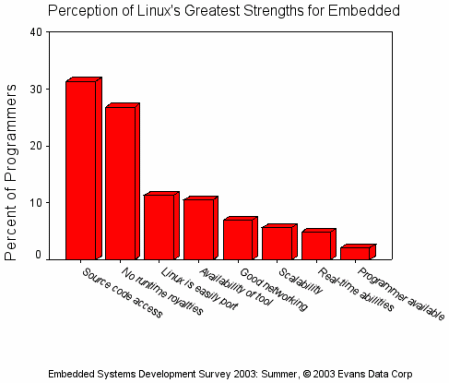
Perception of Linux's Greatest Weaknesses for Embedded
No single complaint stands out, with the exception of real-time issues at 17 percent. EDC notes that very good real-time performance is achievable with a modified Linux system, and surmises that either developers are not yet comfortable with those modifications or they're not aware of them.
EDC notes that lack of commercial support, the second-highest concern, is mitigated by Linux vendors who do provide support (albeit, for a fee), and free community support through newsgroups and websites.
The perceived lack of high quality development tools may point to an opportunity for tool vendors, according to EDC, which notes that a good place for such vendors to start would be to ask what is wrong with the GNU tools, since they are so popular and versatile.
EDC suggests examining the three issues that concern developers the least: GPL issues, “Linux is not stable,” and supplier viability. Recent lawsuits notwithstanding, the majority of Linux developers probably have nothing to worry about when it comes to the GPL, according to EDC. Linux is widely regarded as a very stable operating system. Supplier viability is not a big concern because Linux can be downloaded from thousands of sites for free.

What Percent Expect to Release an Open Source Program This Year?
EDC sees little compelling reason for a company to create a software work and then sell it under an Open Source license, unless the software is merely an adjunct to some money-making product or service that can't be easily copied. Then, the vendor might give away the software as Open Source to promote sales. For example, a hardware manufacturer might distributed associated software to encourage experimentation with the hardware.
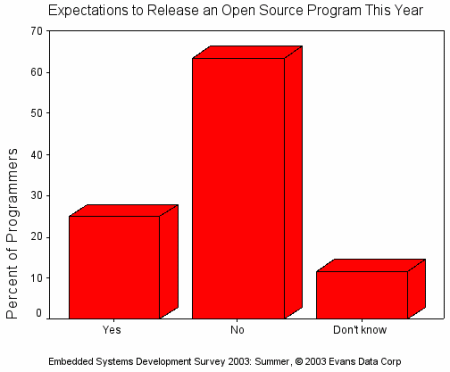
What Percent Expect to Use Open Source Code This Year?
There is a way to make money by creating derivative works of Open Source software. Many Open Source licenses allow binary-only distributions of derivative works. Here is where the distinction between Open Source and Free software becomes critical: Free software, such as that distributed under the GPL, cannot be modified and distributed in binary-only form.
According to this survey, a relatively high percentage of developers (53 percent) expect to use Open Source software this year. This does not necessarily indicate that developers understand all the legalities of Open Source and Free software. In addition, these results do not reveal how many developers intend to sell derivative works, or merely use Open Source software to support in-house projects.
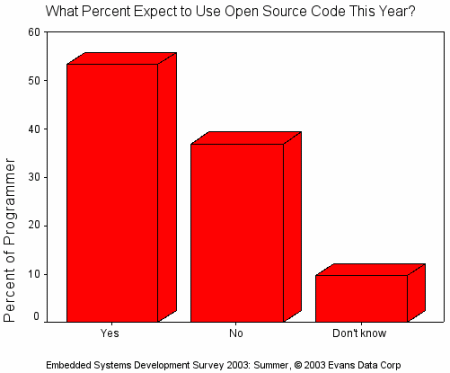
Above text and graphs are copyright 2003 © Evans Data Corp. (EDC). Reproduced by LinuxDevices.com with permission.
This article was originally published on LinuxDevices.com and has been donated to the open source community by QuinStreet Inc. Please visit LinuxToday.com for up-to-date news and articles about Linux and open source.